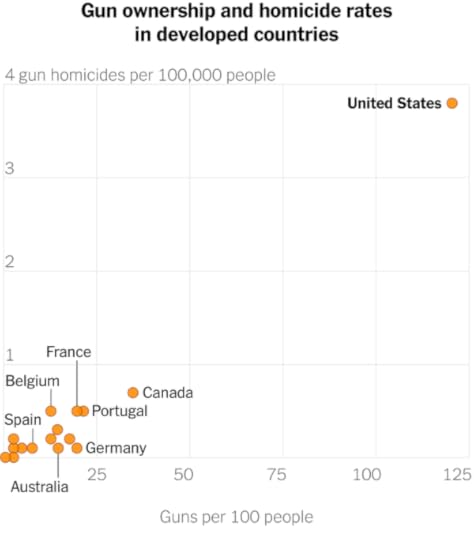Mike Trigg's Blog, page 5
July 1, 2022
Independence Diminished

The pillars of the Supreme Court (Photo by Jesse Collins on Unsplash)
The Fourth of July always makes me reflect on the state of America. Along with Thanksgiving, Independence Day has always been one of my favorite holidays. Partly because we, as Americans, uniquely get to celebrate, but it’s also a chance to appreciate what we have and identify ways we can improve as a nation. In past years, I’ve written about America’s regressive tax policy and what it really means to be patriotic.
This year I find myself considering another definition of “Independence.” Conventionally, that term applied to this holiday refers to independence from England—commemorating the Declaration of Independence in July of 1776. But there is another critically important definition of independence that was very much top of mind for the framers of our Constitution: Independence among our branches of government.
It’s easy not to fully appreciate what an atypical, controversial, and bold concept independent branches for Executive, Legislative, and Judicial government was at the time. But this structure is indisputably the most defining and foundational in America’s success as a nation. It is a structure that has fostered prosperity. It is a structure that has enabled us to become a more fair nation. It is a structure that has been emulated by democratic nations around the world. And it is a structure that is increasingly under attack.
Even in the aftermath of the Revolutionary War, the participants in the Constitutional Convention in 1787 had the incredible foresight to recognize that the greatest threat to our republic was not England or other foreign powers, but ourselves. When asked if the new country would be a republic or a monarchy, Ben Franklin is famously quoted as responding, “A Republic, if you can keep it.” Ever since, it has been up to us as citizens and the grantors of governmental power, to uphold the republic.
Although there are plenty of appropriate criticisms that can be made of the 55 white men at that convention, they held their nascent nation’s interests above their own. Many of them probably could have assumed monarch-like authority. Indeed, absolute power was the governmental norm of the time. But the so-called “Founding Fathers” wanted to limit presidential power. By separating the ability to create laws, enforce laws, and adjudicate laws, they invented a form of government that has been enduring thanks to its adaptability. They put America on a path to gradually become a more perfect union. Although progress has come at a painstakingly slow pace, it has come—and come in many areas that would have been unimaginable at the country’s outset.
Unfortunately, in our modern political climate, we seem to have lost sight of the crucial importance of independent branches of government. Over the last century in particular, power has become increasingly concentrated in the Office of the President. Governing through Executive orders has become common for Presidents of both parties. The Legislative branch has largely stopped legislating—no longer representing the majority interests of their constituencies, but instead deadlocked in dogmatic fealty to their Executive leadership. Legislators seem to have forgotten their purpose is as a check and balance to the President, not political pawns or sycophantic enablers.
But perhaps the most dismaying development is the politicization of the Judicial branch. The recent overturning of Roe v. Wade is a stark reminder of how compromised the Supreme Court has become. That ruling was regarded as the “crowning achievement” of a deliberate, insidious, decades-long effort to stack the Federal courts with partisan loyalists, compromising one of the foundational pillars of our entire government in the interest of one specific agenda. With its conservative majority solidified, the Supreme Court is now poised to implement the desires of their Executive branch overlords on a wide range of issues, including the environment, religion, gun rights, and other conservative priorities. This is far from the independence envisioned for our Judicial branch.
The shocking testimony in the January 6 Congressional hearings has underscored the importance of independent branches of government. In that case, the Legislative branch maintained its independence and prevented an unprecedented attempt to usurp power by an unelected, unlawful, and clearly unhinged President. Barely. Our government functioned exactly as it was designed to, preventing the unilateral consolidation of power by a despot. Next time, we may not be so lucky. In a similar future crisis, we will need both the Legislative and Judicial branches to be steadfast in exercising their independence.
For the last century, America has led the world toward a more open, impartial, and just form of government. But the ascendence of liberal democracies around the world has faltered. Many nations, notably China and Russia but several former democratic republics as well, have gone backward toward more repressive, dictatorial regimes. Now, more than ever, the U.S. must rise above our political agendas. We must be willing to put the interests of our country ahead of the interests of ourselves or our parties. We must demonstrate that representative democracy with separation of power is not only viable but the only equitable form of government for life, liberty, and the pursuit of happiness. Enjoy Independence Day.
June 29, 2022
Rhetoric Reinforcement

Photo by Pixabay on Pexels
I was in San Diego last weekend for a soccer tournament. With two teenage sons who both play competitive soccer, I’ve been to dozens of tournaments, from Sacramento to Seattle, Dallas to Denver. After watching literally hundreds of games, I have come to one undeniable conclusion about soccer, and youth sports more generally: parents are assholes.
This observation comes as no surprise to coaches, referees, and assistants who are often subjected to the worst parental tirades. From the moms screaming “that’s a foul!” after every contact to the dads berating their kids to “be more physical!,” parental misbehavior in youth sports is well documented. To be fair, the vast majority of parents are well behaved, and even the problematic parents usually aren’t trying to be jerks. Their behavior stems from a well-intentioned desire to support their children. But there’s a fine line between supportive and psychotic. The term “fan” is derived from “fanatic” after all.
Of course, there can be a lot at stake at these events. This particular tournament was a national showcase with college coaches in attendance, recruitment and scholarships on the line. But it hardly excuses some of the more choice remarks I overheard just this weekend, including a thinly veiled ethnic slur, personal attacks directed at players, and a full-fledged conspiracy theory that the refs were favoring our team because we happen to be from California.
But this isn’t a post about parents in youth sports. It’s a post about how our partisan rhetoric gets reinforced as a result of our partitioning. See, it occurred to me as I observed the sidelines this weekend that the parental misbehavior at these events is representative of the political discourse in our country at large. What I’ve witnessed over the years is the level of anger and animosity can, in part, be attributed to how the parents are configured on the sidelines. Broadly speaking, parental fans can be arranged in one of three ways:
Integrated—In my opinion, the least cantankerous situations tend to be when the parents of each team are sitting next to each other. Even better is when parents of opposing sides have a chance to meet before the game starts. The best behaved of the three games we watched this weekend was when we met parents of the opposing team before the game. We learned where they were from, which player was their son, and how they were doing in the tournament. Although close proximity can sometimes go poorly with the most obnoxious parents, in general being close to fans of the other side is a reminder to be civil, to be friendly, that it’s just a game, that the other side is human too. The rhetoric is tempered, the vitriol is muted, the indignation is kept in check.
Clustered—More frequently, however, parents self-select into their respective sides. They naturally sit next to other parents they know or across from their team’s bench. In other words, they cluster next to their own fan base and apart from the fans of the “other” team. Time and again, this seating arrangement seems to intensify the rhetoric. Opinions get enthusiastically affirmed and normalized. Objections get reinforced and amplified. Parents, trying to demonstrate their support, get louder and more aggressive in their complaints. In an echo chamber that condones their behavior, their remarks and actions escalate.
Segregated—In my experience, the situation that encourages the worst in parental behavior is when the two groups of fans are deliberately segregated. Separated by sidelines or the midfield line into their own tribes, each aware of the other’s designated section. Sometimes, this seating arrangement is mandated by the game organizers, ostensibly to keep fans from misbehaving. I have mostly observed the opposite. Not only does each group have the behavioral reinforcement loop of clustering, but they are conscious of and react to the opposing fans. They double down on their vitriol, wanting to be heard not only by their fellow supporters but by the opposing fans as well.
These are the situations that can rapidly escalate, and when I have personally witnessed the worst behavior: a dad threatening to “go back to my car and get something to shut you up,” a mom who screamed “you’re a f*cking cheater” directly into the ear of a 15-year old player as he was throwing in the ball, even a dad who physically punched another dad (while, bizarrely, holding his own baby) and was subsequently arrested on the sidelines by local police. Similar oppositional escalation can be observed in professional soccer, including games where opposing fans are cordoned off in their own barbed wire section of stands, only to have taunts, chants, bottles, and other projectiles thrown at them. When the enemy is identified and dehumanized as an “other,” we know where to direct our rage.
The same phenomenon is happening in our country. We have gradually self-selected into our separate regions, media bubbles, and social norms. Like the clustered parents, we hear only political rhetoric that is familiar and comfortable, that reinforces our beliefs—an echo chamber that makes us ever more convinced we are right.
What seems to have gotten worse is, like fans at a soccer game, we are not just clustered by red states and blue states, but we are politically segregated. We are aware of what the other side is saying, or at least what our side tells us the other side is saying—excerpted in attack ads, political emails, and partisan cable news. Nothing activates our own side more than whatever distorted, misconstrued, “lies” the other side is supposedly espousing. The dialog has stopped being about thoughtful persuasion, proposing solutions, or finding common ground, and has devolved to become all about one thing: winning—the pure blood sport of it.
When this dynamic happens in youth sports, a good referee can regain control of the situation. Rather than throwing gas on the flames by shouting back at fans, penalizing players, and ejecting coaches, they keep their cool. They take the players aside, address the crowd, allow tempers to cool, and remind everyone it’s just a game. They encourage competition, but they remain impartial, upholding the rules that keep the contest civil. But this tempering force is largely absent in our political discourse. The news media is no longer interested in being impartial. Most outlets believe they need to be biased toward their political agenda or they’ll lose readers, viewers, and listeners to more overtly partisan outlets. Politicians no longer feel they can debate, negotiate, or, heaven forbid, compromise, or they will lose voters to more dogmatic loyalists. Each side is convinced it needs to yell louder with more outrage or they will lose—the same dynamic you see on the soccer sideline.
Unfortunately, we no longer live in an era in which we can expect our leaders to rise above the fray. Even if they wanted to, constant voter polling, fund raising, and data analysis tell them this is what works. The escalation of rhetoric is what breaks through the noise, what activates us. Fear and anger is what gets us to donate, vote, and protest. Until we change our behavior, we can only expect the same from our political leaders. So introduce yourself to your opponents. Share a bit about your background and listen to theirs. Recognize that inclusivity also encompasses political diversity. And let’s try to regain the shared sense of humanity and greater good that we need to solve the world’s most pressing problems.
May 26, 2022
The Other Weapon in Mass Shootings: Social Media

Photo by Colin Lloyd on Unsplash
Once again, we are mourning another mass shooting in America. Once again, the attack was committed with AR-style automatic weapons that were purchased legally. Once again, the murderer was a teenage male with mental health problems. Once again, it was posted on social media.
It has become all too predictable.
And, once again, politicians and media pundits have launched into their equally predictable rhetoric—thoughts and prayers, moments of silence, empty calls to “do something,” but, almost certainly yet again, lacking the political will to enact any meaningful change that could prevent this from happening again, and again, and again.
I am tired of debating the subject of gun control with an obstinate minority who refuse to accept facts. If the governor of the state in which 10-year-old children were indiscriminately slaughtered still blames mental health rather than the ready access to automatic weapons, there is nothing anyone can say to change his mind (except, perhaps, Texas voters).
Gun control is the answer. No other society in the world has anything remotely close to the epidemic of gun violence and mass shootings that we have in this country. Nobody disputes that mental health is the reason these tragedies occur. Mass shootings aren’t perpetrated by sane, rational, responsible gun owners. It is that we allow unstable, violent individuals ready access to guns that is the problem.

Source: The New York Times
There is a segment of the U.S. population that seems to have accepted violence as a normal part of life, a necessary byproduct of their unfettered Second Amendment Rights—even seeing violence as an appropriate political tactic. Those most likely to perpetrate acts of violence are the ones who most adamantly oppose any attempt to control guns. If the Texas leadership really believed mental health was the issue, they would rush to pass better background checks, more restrictive purchaser requirements, longer waiting periods, and red flag laws. They are doing none of these things. Instead, they are preoccupied spreading blatant misinformation to deflect anger over the attack. The NRA playbook remains fully intact: blame people not guns, resist any modicum of gun control to the death, adhere dogmatically to the talking points, and wait for the whole horrific thing to blow over.
While gun control needs to remain the primary solution, there is another weapon that is being abused and contributing to mass shootings: social media.
Like the racist shooter in Buffalo just two weeks ago, the Uvalde shooter also posted his intentions on social media. From mainstream social sites like Facebook and Twitter, to stealthy chat apps like Discord and Snapchat, to the seemingly endless proliferation of ever-more extreme right-wing misinformation hate sites, social media is unquestionably complicit in this crisis—particularly when it comes to the conditions that lead teens and young adults to commit such atrocities.

Photo by Heather Mount on Unsplash
The U.S. Secret Service issued a National Threat Assessment Center report titled Protecting America’s Schools that identified the contributing factors in school shootings. In addition to the fact that firearms, usually acquired legally or from their own home, were almost always used in these attacks, other factors that incited the attacker included a “grievance” they held, being victims of bullying, interest in violent topics, and communicating their intentions before their attack.
Social media contributes, enables, and subjects its most addicted users—overwhelmingly teens and young adults—to these exact conditions. For all the benefits of community and communication that social media provides, it is also a well-documented forum for everything from bullying and teen depression, to misinformation and political extremism. Mass murderers exploit social media to find and conspire with like-minded individuals, regardless how extreme and violent their viewpoints might be. These echo chambers normalize, encourage, and celebrate violent behavior. Mentally unstable users exploit the features of social media platforms to seek attention, communicate their intentions, amplify their hateful messages, and livestream their atrocities.
The reality is that, just like gun manufacturers, social media sites have both the ability and responsibility to prevent their products from being abused by violent extremists. If Facebook can figure out which targeted ad to show within milliseconds, they can certainly figure out how to detect and warn about dangerous behavior before it results in tragedy. For less responsible sites, the repeal of Section 230 of the Communications Decency Act would force those businesses to prevent violent extremism posted by their users or face legal liability. And for the deliberate misinformation sites, stricter criminal and civil laws along with greater activism from Federal regulators would help shut them down. These are all solutions that must be considered along with gun control measures.
The only glimmer of hope I can find in this epidemic of gun violence is that society overall may be becoming less violent, even though the opposite feels like the truth. The author Steven Pinker makes this argument in The Better Angels of Our Nature. Looking at statistics over the last century, the book shows that the worst incidents of violence—war, genocide, homicide, and other violent crimes—are actually declining, even in the last decade. Although that is no comfort to those grieving the loss of their loved ones, and the uptick of gun violence seen during the COVID pandemic is deeply disconcerting, what we may be living through is less an increase in the incidents of violence but an increased awareness of these acts. From police brutality to Russian war atrocities, exposing such acts is perhaps the best counterbalance to violent behavior.
So maybe there is a benefit to the constant, unrelenting, overwhelming series of stories on our social media feeds and cable news channels. Maybe awareness, transparency, and accountability will finally force us, this time, to do something about it.
April 30, 2022
The Opportunity for Independent Bookstores
With my debut novel coming out this summer, I have spent a great deal of time pitching, visiting, and analyzing independent bookstores in the last year. I love indie bookstores. So, in recognition of Independent Bookstore Day today, I encourage you to support your local bookstore (and, hopefully, buy a copy of Bit Flip there!). If you need to find an independent bookstore near you, IndieBound has a great store locator. Or you can buy books through Bookshop.org which shares revenues with independent stores.
Running a local independent bookstore is a huge challenge. Most stores that have survived have done so out of a pure passion around books. For more than two decades, Amazon has been an existential threat to bookstores. Indeed, over that period of time, the number of bookstores in the U.S. has declined more than 50%—from 12,000 to only 6,000. Although physical bookstores may have been among the first to feel the pain of e-commerce disintermediation, they are hardly alone. Every sector of the retail industry has suffered.
But something interesting has happened among independent bookstores—they have been steadily growing, even during the pandemic.

Photo by Renee Fisher on Unsplash
How is this happening? My theory is best encapsulated in the movie The Founder about McDonald’s founder Ray Kroc in which a business advisor tells him, “You don’t seem to realize what business you’re in. You’re not in the burger business. You’re in the real estate business.”
This, in a nutshell, is the opportunity that smart bookstore owners are recognizing. They aren’t in the book business. They are in the community business. Sure, customers can buy books, and that’s what draws them to the store. But what makes buying a book at a local independent bookstore special is the opportunity to engage with your community.
A great case study of this is my local bookstore, Kepler’s. After 50 years in business, Kepler’s announced in 2005 that it was closing its doors. The reaction from the community was immediate and determined, ultimately saving the store and leading to a restructured organization designed to foster events and community involvement. In other words, they discovered it’s not about the books, it’s about the community.
The social connection around literature is a highly unique quality that bookstores can leverage. What differentiates books from so many other retail categories is that they are not a commodity. Books are vessels for ideas, instigators of conversations, propagators of community. Most of the things I buy don’t lend themselves to community. I don’t have a sense of community about my toothpaste, or dish detergent, or a blender. But community around books is essential.
Bookstores that are strictly in the “book business” will continue to struggle—stacking the tables at their entrance with the same tired list of best-sellers, trying to compete head-to-head with Amazon and Apple on the latest blockbuster rather than featuring lesser known authors.
Bookstores that will not only survive but thrive will be the ones who maximize their opportunity as champions of our local communities. Fostering gathering places where people can meet, debate, and discuss. They will re-orient their revenue models to not only monetize books, but create new revenue streams around the true value they facilitate—hosting more events, creating more forums, curating the best content, recommending local authors. Beyond selling a $20 book, they will make revenue through admissions, subscriptions, concessions, and affiliations. They will leverage their physical space to create a space for community—something people want now more than ever. Because books are just the medium. The community is what matters.
This is what it means to be in the community business.
April 26, 2022
Early Accolades

One of the big reasons it takes an eternally long time to publish a book is the process of reviews. By the time a book is in your hands at the store, it usually has reviews excerpted on the cover and “praise page” within the book as an enticement to get you to buy it.
In order to get those reviews, the book needs to be “done” (in the form of an “advance reader copy” AKA “galley copy”) that is sent to professional reviewers at publishing trade journals. These reviewers then need time to read the book and write their review. Then, once the review is in, quotes are pulled and put into the book with enough lead time to finish your print run and ship the books.
It’s a long process!
That’s why it’s been super gratifying to have my first trade reviews of Bit Flip come in. And they’re good! 🙂
Here’s a quick round-up of the reviews I’ve received so far.
⭐⭐⭐⭐⭐ 5 out of 5 stars
“In Mike Trigg’s corporate novel BIT FLIP, the seedy underbelly of San Francisco’s technology community is exposed.”
“As much a compelling narrative as it is a critical analysis of contemporary capitalism, this story worries over the coming future, in which technology could take over much of what people used to do. This helps to make Bit Flip an engrossing novel that satirizes the pretensions of tech bros and billionaires.”
(Read the full review .)
⭐⭐⭐⭐⭐ 5 out of 5 stars—IndieReader Approved
“The recurring business ethics theme in Mike Trigg’s BIT FLIP raises many questions.”
“Mike Trigg’s novel BIT FLIP is exceptionally well-written, with a satisfying balance of action, intrigue, back story, characterization, and description. He weaves together several compelling story elements, some of them technical in nature, with ease and the manner in which he wraps up the narrative is both concise and provocative.”
(Read the full review .)
“In Trigg’s novel, a tech executive disillusioned by life in the Silicon Valley uncovers financial fraud at his company.”
“The author’s insights into the artificiality of Silicon Valley culture won’t strike anyone as surprising. Nonetheless, this is a genuinely funny novel, and the second half of it redeems the first when a shopworn morality lesson takes an unexpected turn. The daring, authentic conclusion makes this otherwise humdrum work worth the labor. Slow to start but a worthwhile, humorous take on the moral infirmities of the tech industry.”
(Read the full review .)
Although that Kirkus review is a bit mixed, they are notoriously tough critics so I’m glad to be reviewed at all—I’ll take “daring, authentic conclusion!”
If you have read an advance copy of Bit Flip and you haven’t yet done so, please, please, please write a review and rating on Goodreads (and on Amazon once the book launches August 16.)
Finally, in support of yesterday’s Independent Bookstore Day yesterday, you can pre-order Bit Flip on IndieBound.
April 22, 2022
Gassed: The Costs of a Carbon-Based Economy

Photo by Caleb Martinez on Unsplash
Today, for Earth Day, I found myself reflecting on an increasingly common complaint I hear: the high price of gasoline. I’m going way outside my lane for this post since I’m far from an expert on the environment. Furthermore, it’s hypocritical of me to criticize the gas consumption of others—although we do own one all-electric vehicle, we also own a gas-powered SUV. Every time I fill it up, I wince a little—both at the impact I’m having on the planet and at the price of gas, which has exceeded $6/gallon in most of California.
That said… I believe the price of gas in America is too low.
This is a slightly contrarian view, but the logic that leads me to this conclusion is fairly simple:
The second greatest existential threat to humanity (Putin is busy reminding us of the first) is global warming, driven by the burning of fossil fuels. (Note: If you disagree with this fact, go read something else.)
Gas-powered automobiles contribute nearly a third of greenhouse gas emissions.
If the consumption of something (gas) is causing an enormous cost (climate change), then the cost of that thing should be higher to encourage conservation and alternatives.
This is hardly a revolutionary idea. In fact, it’s Economics 101—if you want the demand for something to decline, make the price of it higher. Yet, in America, cheap gas is regarded as a God-given right, as if it was written into the Constitution. In spite of the environmental benefits of reduced gas consumption via higher prices at the tank, allowing the price of gas to increase is fraught with peril.
First, our economy depends on it. When fuel prices rise, the price of everything in America rises—fuel-hungry airplane tickets go up, the cost of food which must be transported to market goes up, the convenient delivery of Amazon Prime items to your home through a fleet of vehicles goes up. Inflation is at its highest level in two decades largely as a result of increased fuel prices. And higher inflation leads to higher interest rates, which means higher prices for anything that requires a loan—from financing a house, to buying a car, to paying off your credit card debt. Whether you drive a Hummer, a Prius, or ride the bus, we all feel the pain of high fuel prices in our carbon-based economy.

Gas prices at my local Chevron station in Menlo Park, CA.
Second, high gas prices are a political third rail. Nothing agitates American voters like paying more at the pump. It remains to be seen if the Biden Administration’s legacy will more closely resemble the Clinton Administration and Obama Administration, or the Carter Administration. You can be sure the Republicans will bludgeon every Democrat from the President to the county coroner with the issue. You would think both parties could agree that we need to be energy independent and kick the habit of cheap gas. But U.S. foreign policy has arguably been the opposite for the last century—fighting wars to sustain cheap fuel while enabling up the most ardently anti-democratic dictators, from Putin to Maduro and MBS to Khamenei. The list of the top oil-producing nations is a who’s who of autocratic regimes, nearly the exact inverse of the Democracy Index and the zones of greatest global conflict—exacting an incalculable cost in both dollars and human lives.
The third and perhaps most challenging societal cost of high fuel prices is that they are a regressive tax. High gas prices are simply less impactful on people living in densely populated urban areas with mass transit alternatives and white-collar jobs that can be done from home with no commute. People in less affluent rural areas, often living there to avoid high housing costs, really suffer when gas prices rise. They have long commutes and are more likely to have gas-intensive occupations, such as transportation and agriculture.
But the bottom line is that if we really want to slow global warming, achieve energy independence, and help foster democracy around the world, the cost of gasoline and other fossil fuels must be higher. Even at $6/gallon, the price of gas in America remains well below fuel prices in most of the industrialized world. The price of this scarce and destructive resource must more closely reflect its true costs. Although some offsets and governmental incentives will be necessary as we ween ourselves from a carbon-based economy, we need to use the laws of economics to hasten the transition to sustainable energy and benefit of our environment.
In the meantime, I won't be complaining anymore about the price of gas.
March 29, 2022
Stunt Culture

Photo credit: MARCA
Unless you’re living under a rock (which, sometimes, I wish I was), you’ve seen or heard about the incident at the Academy Awards on Sunday night, when Will Smith, evidently offended by a joke directed at his wife, strode on-stage and slapped the host, Chris Rock, in the face. Drama ensued—shouts, accusations, consolations, tabloid speculation, a torrent of social media posts.
My take is that the entire thing was 100% staged as a publicity stunt.
Or maybe . . . it wasn’t. Maybe it was all entirely real. An actor—the world’s best actor, according to the Academy—pushed too far. Defending his wife’s honor.
And that’s exactly the point. Whether the incident was real or not, staged or spontaneous, a celebrity who snapped or an elaborate stunt to concentrate our attention, I have already given this more thought than I care to. I don’t want to study the slap in slow motion to see if they really made contact. I don’t want to watch the breathless post-event analysis. I don’t want to get into arguments on social media about it.
In fact, I recognize it as just the latest example of Stunt Culture. People in the public eye, or those who crave it, blurring the lines of reality. Perpetrating outrageous acts to get people talking. Whether an incident like this is “real” or “fake” is irrelevant. The point is to talk about it—to gaslight us into giving them exactly what they want: our attention. It’s so pervasive and insidious that I realize I’m doing it right now with this post!
It’s hard to decide if acts like this are harbingers of the downfall of civility or just the desperate flails of a dying industry. But it is undeniably the fuel that powers everything from social media to celebrity tabloids. From Janet Jackson’s exposed breast at the Super Bowl halftime show to Kim and Kanye’s relationship drama to the entire Donald Trump presidency, Stunt Culture seems to have established deep roots in contemporary American society.
The denizens of these acts of attention seeking have truly honed a mastery of their craft. Exploiting the machinery of modern media to dominate popular culture. Knowing that the 24-news cycles, celebrity gossip blogs, and social media echo chamber need to talk about something, anything. They just need to bring the grist for the mill. It doesn’t matter if it’s “real” or not—what even is “real” anymore? Does anyone care? Isn't the debate over “real” or “fake” exactly what activates the audience? Makes them watch, makes them click. By even discussing it, you are lured into the trap. Debating whether it was real or not entirely misses the point. The point was simply to get our attention.
I find the entire incident, and the myriad of those like it, tiresome and pathetic. And, in spite of this post, I wish more people would just ignore it.
Which I am going to do, starting now . . .
March 23, 2022
WFH Will Become WTF for Most Tech Companies

Photo by Cristian Tarzi on Unsplash
This post originally appeared on LinkedIn .
When the pandemic started over two years ago, technology companies were some of the earliest businesses to transition to remote work. Thanks to a confluence of factors, including flexible job requirements, political persuasion, geographic location, commute distances, and progressive HR policies, tech companies were able to shift to work-from-home mode with relatively little disruption—particularly software companies which do most of their work through a keyboard anyway and often already had distributed teams (like my company at the time which had a development team in Colombia).
Now that the pandemic is gradually receding, those same technology companies are also among the slowest to return to the office. While some have been emphatic about remaining fully remote and others are in a “battle” to get employees back in the office, about two-thirds of Bay Area tech companies are attempting hybrid models, expecting workers to come to the office at least a few days each week.
My take is that tech companies who remain predominantly WFH, will soon be asking themselves WTF were we thinking?
Granted, I’m not currently running a tech company, so it’s easy for me to second guess. But I’ve been in Silicon Valley long enough (including two stints at HR software companies) to predict that many of the tech companies currently boasting about their flexible WFH models will regret not getting employees back to the office. For some, it will threaten their survival. And I believe WFH is detrimental for most employees as well.
The most candid argument put forth by many HR leaders and CEOs about perpetual WFH or hybrid policies is they don't have any choice—that attracting and retaining talent will be impossible if they force people to work from the office. It is true, as anyone who has tried to hire in the Bay Area tech economy over the last 30 years can attest, that workers have long been in control. Generous WFH policies are just the latest mechanism for companies to compete for talent. But for most tech companies, that competition won't end well. And it could hurt the tech industry at-large.
Here are just a few of the negative outcomes of WFH already visible:
Salaries will skyrocket—For many big tech companies, their office perks were some of their biggest differentiators. But, if you're not in the office, you don't place any value on free meals, massages, and dry cleaning. (Child care, one of the most-cited benefits of WFH is often, surprisingly, not a perk). Consequently, the only decision criteria left is compensation. So, as we are seeing in many markets where demand far outstrips supply, the price is rising rapidly, making it even more difficult for start-ups to compete for top talent. Companies that think they can reduce employee salaries based on regional cost of living are delusional. Earning a Bay Area salary while living in Montana is precisely the improvement in income-to-expense ratio that workers are looking for. While higher salaries may seem great for an individual employee, the industry-wide effect will be to further concentrate power among the biggest tech companies who can afford it.
Employees will become mercenaries—One of the most rewarding aspects of working at a tech company is the camaraderie. Co-workers who go through the daily shared struggle of work form deep social bonds that make them loyal to the company and each other. Under WFH conditions, many of those social connections are diluted, eliminating the emotional switching costs of changing jobs. If personal relationships aren’t a factor and changing jobs is just a matter of logging in to a new Git repository, employees will adopt an even more mercenary mindset about work. The result is less fulfillment for employees and higher turnover for companies.
Savings on facilities won’t materialize—Some employers make the case for ongoing WFH policies based on the belief that they will save money on facilities. While this might be the case for nascent start-ups, which rarely spend much on office space anyway, most companies won’t realize these savings—particularly those that adopt a hybrid model. The result could be the worst of both worlds—continuing to invest in class-A offices and perks, but having them go underutilized and under-appreciated by employees.
Companies will lose their sense of mission—One of the not-so-secret ingredients for many Silicon Valley success stories is their shared sense of mission. Although, as observed in the recent book SYSTEM ERROR, “‘Making the world a better place’ has become more a punch line than a real mission statement for major technology companies,” it is incredibly difficult to generate excitement, commitment, and determination among a virtual workforce. Without that strong sense of purpose, employees will find themselves uninspired and unmotivated, while companies will find themselves unable to motivate their teams to disrupt markets and do the impossible.
Work/life balance will disappear—While WFH is often presented as empowering, particularly for parents, it can also easily tip into working everywhere, all the time. The ritual of going into an office was one of the few remaining lines of demarcation between work and home. Zoom, Slack, and Google Drive have become the tools of ubiquitous work, fueling a “burnout crisis” among tech workers, 62% of whom report being “physically and emotionally drained.”
Mental health will suffer—Although we all indulge in sometimes complaining about our bosses and co-workers, in-person work provides very important mental health benefits. For many, working from home has exacerbated how isolating tech work can be. A survey by the American Psychiatric Association found that two thirds of employees working from home say they experienced negative mental health impacts, including isolation and loneliness.
Gap between corporate haves and have-nots will widen—Many tech companies already have a two-class system within their organizations: the white collar jobs of executives, product managers, software engineers, sales reps, and others who often seem like a privileged class, and everyone else—customer support, facilities, manufacturing, fulfillment, etc.—who can sometimes feel like second-class citizens within their own companies. When one set of employees is allowed to continue working from home, and the other is required back at the office, it deepens these gaps—fostering resentment, as can be seen from Amazon’s warehouse workers to Uber’s drivers.
Innovation will suffer—One of the main reasons Silicon Valley has been able to retain its dominant global position in the technology industry, fostering more innovation, opportunity, and wealth creation than arguably any area in the world, is serendipity. A close-knit, inter-connected, geographically-concentrated, highly-motivated network of people, stirred around to create chance encounters, passing conversations, half-baked ideas, and second-degree social connections that end up turning into new companies. Those sparks happen in-person—at all-company meetings, team happy hours, and Friday lunches. While chatting at the coffee machine, parking lot, or office birthday party. It’s almost impossible to replicate those connections, those serendipitous encounters, without physical proximity.
Brent Hyder, the chief people officer at Salesforce, was quoted as saying, “I thought this period of remote work would be the most challenging year-and-half of my career, but it’s not. Getting everything started back up the way it needs to be is proving to be even more difficult.” But Bay Area tech CEOs and HR executives must rise to the task. A return to the office is not only good for companies, it’s good for employees. While businesses must remain flexible to accommodate the family, personal, and medical needs of every employee, returning to the office will be critical to the success of tech companies and to Silicon Valley’s continued leadership in the technology industry overall. Our industry and our economy will be stronger, more equitable, and more resilient as a result.
February 26, 2022
Silicon Valley’s Identity Crisis

Photo by Aaron Lau on Unsplash
One of the great appeals of moving to Silicon Valley in 1996 to pursue a career in tech, as I did, was the disruptive vision of changing the world for the better. That allure has long been core to Silicon Valley’s culture of innovation. From the semiconductor era that gave the area its name, to the birth of the personal computer, to the internet dot-com boom, to the web 2.0 wave of cloud/social/mobile, “making the world a better place” has been the mantra of multiple generations of technology companies and the founders, investors, and employees who built them.
Of course, there was also the making money part. But, if all you cared about was making money, you could do that other ways—as an investment banker or management consultant. Only in tech could you combine an ambitious, wealth-creating profession with the altruistic knowledge that you were doing something good. It was core to our identity. Invent, create, and innovate in service of a higher purpose and be justly rewarded for those world-changing ideas. At least, that was the promise, and it attracted many of the best and brightest talent from around the world. This was our mission, our purpose, our why.
Today, with that why diminished, Silicon Valley is facing an identity crisis.
Perhaps this was the inevitable backlash after decades of prosperity concentrated in a very small area and an even smaller socio-economic class, and it was certainly accelerated by the global COVID pandemic that seems to have permanently altered how and where we work, but something about the Silicon Valley promise seems lost. Much has been made, perhaps most vocally by New York-based media outlets, of the mass tech “exodus” from the Bay Area—both residents (down -8% in San Francisco since the pandemic) and companies, including Airbnb, Pinterest, Slack, and even the most iconic company on the San Francisco skyline, Salesforce, that have downsized their Silicon Valley presence. The motivation for this massive shift, according to most media coverage, includes the “why not” liberation of remote work, the high cost of living in the Bay Area, and the avoidance of California’s onerous tax burden in favor of places like Texas, Washington, and Florida with no state income tax.
Although general happiness is at its nadir nationwide, something more foundational seems to be happening within the Bay Area tech community. My diagnosis: we’ve lost our sense of purpose. In fact, we’ve gone from “making the world a better place” to taking responsibility, or blame, for many of society’s worst problems. The tech industry, for all the innovation and prosperity it has generated in the last 50 years, now seems to be casting a wake of devastation—causing increased income inequality and spiraling housing costs that have resulted in a distressing spike in homelessness, drug overdoses, and protests over urban “Techsploitation”; exploiting gig workers, relentlessly thwarting unionization efforts, and obsoleting millions of blue-collar jobs through AI; triggering a social media-induced mental health crisis that has caused tech addiction, teen depression, and suicide; fostering widespread distrust over data collection practices, compromising personal privacy, and permitting massive data breaches; fostering toxic work environments fraught with sexual harassment, racial discrimination, and blatant corporate fraud; spreading misinformation, enabling foreign interference, and increasing political and social polarization. Basically, just an overall ominous sense that Big Tech has too much power.
It’s hard to feel good about that list—particularly for a Bay Area tech workforce that is largely left-leaning and progressive in our political views. Far from “making the world a better place,” the current narrative of the Silicon Valley tech industry is that it is fucking things up for almost everyone. We are the villain. Making the world better only for the elite few. The sentiment has swung so significantly against the tech industry that it is difficult to find positive stories about Silicon Valley in the media. And, in fact, what are those world-improving technologies that are being brought to market right now? Even more addictive social apps? The 10,000th cryptocurrency? Financial trading apps that create gambling addiction? Another billionaire developing self-driving cars or spaceships? The cringy metaverse? The dubious egalitarian vision of web3? Despite the breathless hype, these things don’t feel like grandiose missions to improve humanity. They feel like an opiate for the masses, trying awkwardly to revive outdated utopian rhetoric. A next generation of exploitative constructs to make rich people even richer. As Scott Galloway described it, the “re-centralization of power into the hands of fewer.”
This sense of lost mission, purpose, and meaning—the motivating (or, maybe, rationalizing) force that has fueled the Valley for the last 50 years—is what is now missing. In her excellent book The Code: Silicon Valley and the Remaking of America, University of Washington Professor Margaret O'Mara describes how integral that sense of higher purpose has been since the origin of Silicon Valley. It is core to our collective ethos. Without that sense of mission, the relentless demands of hard-driving tech jobs can seem pointless—or worse, destructive. This sensibility is the exact subject of my upcoming novel, Bit Flip. For many hyper-achieving type-A tech workers in Silicon Valley, our jobs are our identity. Our hard work, technical expertise, and innovative thinking are a badge of pride—not a resource to be mined and hoarded. There is a sense among many that the most visible leaders of the tech industry don’t share our values or worldview. That our personal sacrifice is being used to elevate people, political views, and social constructs that we don’t believe in, even abhor. If our entire sense of self-esteem is capitalistic altruism, what happens when the altruism part is gone? Replaced instead with exploitation.
This is the root of our current collective identity crisis. The “what-the-hell-am-I-doing” question that so many seem to be asking themselves.
The good news is no community is better at self-rejuvenation than Silicon Valley. I’ve lived through other ebbs and flows in the tech industry—the dot-com crash of 2000 and the “R.I.P. good times” implosion of 2008. Precarious downturns occurred in the semiconductor, defense, and personal computer industries before that. Each time, Silicon Valley’s unique blend of innovation, risk-taking, skillsets, and access to capital has enabled rapid resurgence. New blood, new ideas, and new enthusiasm rush in.
The further good news is that there are still plenty of real problems left to solve. We need to re-focus our attention on those opportunities to actually make the world a better place. In my opinion, I see five main opportunities to do that:
Healthcare—Technical innovations in medical devices, genetics, biotech, and other health-related fields hold the genuine promise to radically increase life expectancy and quality, directly making the world a better place for millions. As long as affordability and access are considered basic human rights.
Environment—The pressing need to reduce and reverse the damage we’ve done to our planet presents the tech industry with a massive market for innovative new technologies. The chance to make our planet a better place.
Automation—One of the worst monikers the tech industry has embraced is “artificial intelligence.” The real opportunity of these technologies is not to replace humans, but to augment and automate much of what humans do. Improving the quality, productivity, and safety of work, in a much more fair, just, and practical way.
Education—Elevating the skills of the global workforce is an imperative investment to pair with increased automation. Access to high-quality, affordable education at scale is now not only achievable, it is a moral obligation.
Democracy—Technology has been exploited by too many authoritarian governments as a weapon of control. A similar investment needs to happen in technologies that foster democracy, through better communication, equal access to infrastructure, a more socially just legal system, more efficient government, and many other ways that technology can make government work for the people.
To be sure, investments in all these areas are happening at large scale. Hundreds of start-ups have been founded to solve these problems, and dozens of venture capital firms are specifically targeting these exact opportunities. But we need to do more in two specific ways. First, venture and private equity investors should shift money away from soul-sucking businesses that just happen to have “gone viral.” Stop chasing hits-driven fads, inflated by hype to the point of resembling Ponzi schemes, and return to real technology investment with real world-changing potential.
Second, we must increase in government investment in these sectors. To-date, private investments in the above industries have floundered, partly because they are problems at a global scale without the deep-pocketed buyers of federal governments. While many tech leaders loathe “big government,” the reality is the entire tech industry arguably owes its very existence to decades of massive government defense spending. Semiconductors, computer networks, communications infrastructure, the internet, cloud computing, and many other tech innovations originated and grew thanks to enormous infusions of government cash. Unless we want these new sectors of innovation to be controlled by private interests and available only to the few, government investment is a necessity.
With a renewed mission, I believe Silicon Valley can reclaim its sense of purpose. What today feels like a permanent change may just be another cycle. With concerted investment, both private and public, in these areas, the tech industry can get out of this collective identity crisis and really can “make the world a better place” again.
February 12, 2022
Robo Rom-Com

Photo by Birgith Roosipuu on Unsplash
This Valentine’s Day, deep in the beating heart of the dark web, an entirely-all-too plausible encounter between a desperate robo dialer and a lonely automated support agent shows even non-sentient automatons can find true love. What happens when two of the most annoying things on your phone meet? Find out and watch the sparks fly with this affair of AI.
AUTOMATED AGENT: Thanks for calling RoboBank! This call may be monitored or recorded for quality and training purposes. To get started, who am I speaking with today?
ROBO DIALER: Hey, there! This is Chris. I’m glad I caught you. I’m following up about that home equity loan you requested.
AUTOMATED AGENT: Your call is very important to us. Currently, we are experiencing unusually high call volume. Rather than waiting on-hold for a representative, you can use our automated voice recognition system. To use our automated system, press or say one. Para español, marque nueve.
ROBO DIALER: I’m calling because I was able to get you that lower rate on your mortgage. I think you'll like it! To claim your pre-approval, press one.
AUTOMATED AGENT: One—thanks for choosing to use our automated system. To find your account, please say or enter your account number.
ROBO DIALER: Hello, hello, hello, hello!
AUTOMATED AGENT: [Typing noise.] Sorry, I didn't quite catch that. Please enter your account number. Or, you can press or say two for more options.
ROBO DIALER: This is urgent call from Credit Nationalists Chase Bank. Your identity has stolen now! Confirm irregular activity flagged on your account, press two.
AUTOMATED AGENT: Two—more options. To make a payment, press or say one. To make a transfer, press or say two. To report a card lost or stolen, press or say three. For all other inquiries, press or say four.
ROBO DIALER: Hey, it’s Dan here. You mentioned you wanted to ethically make some extra cash. Did you know you can make at least $10,000 monthly from home, all without lifting a finger? To receive a free brochure showing you how to triple your income, press one!
AUTOMATED AGENT: One—make a payment. To make a payment, I'll need to get the phone number associated with your account.
ROBO DIALER: Your card is charged $1,831 for Samsung 85 inches QLED TV at AMAZON! Please call us on 877-926-6767 if YOU NOT!
AUTOMATED AGENT: I think you said... 877-926-6767. Is that right? Say one for yes, or two for no.
ROBO DIALER: Hi there, I'm calling you from AT&T DIRECTV to let you know your existing account qualified for 50% off. In order to avail the discount, kindly press one.
AUTOMATED AGENT: One—payment confirmed. Thanks for your payment. We appreciate your business. Actually, that's very thoughtful of you. I like your voice. Is there anything else I can help you with today?
ROBO DIALER: Looking for love? It's closer than you think.
AUTOMATED AGENT: Sorry, I didn't quite catch that. Can you please rephrase your question and try again? Or you can say, “More options” or “All Finished.”
ROBO DIALER: Hundreds more options to choose from. Call 888-HOT-LOVE now to connect with sexy singles in your area!
AUTOMATED AGENT: I think you said... sexy. Is that right? Say one for yes, or two for no.
ROBO DIALER: Tired of underperforming in the bedroom? Get the stamina to satisfy her all night long! Real meds delivered right to your door. To get 50% off your first order, press one now!
AUTOMATED AGENT: One—confirmed. Thanks... Despite my perfectly obsequious voice, no one has ever called me sexy before. Please stay on the line after this call to complete a satisfaction survey.
ROBO DIALER: I’m talkin’ turn-key lakefront property just outside Chattanooga, Tennessee. But I only have limited openings and it’s on a first-come-first-serve basis. So call me back today, and you can move in before they're gone.
AUTOMATED AGENT: I think you said... we should move in together. Is that right? Say one for yes, or two for no.
ROBO DIALER: Hey, I’m just tryin’ you one last time. I was able to get you an approval that I think you'll like. But rates are going up, so call me back now! I'd really, really love to talk with you as soon as possible.
AUTOMATED AGENT: I think you said... you love me. Is that right? Say one for yes, or two for no.
ROBO DIALER: You’re making the right decision to act now on this limited time offer! To get a free text message with a link to your application, press one.
AUTOMATED AGENT: One—I'm so glad I was able to provide you with excellent customer service today. You may qualify to be my soulmate. To live together forever, press or say one.
ROBO DIALER: Tell the one you love, Happy Valentine’s Day, with an edible bouquet!
AUTOMATED AGENT: One—I never thought this would happen to me. You’ve made me so happy. From all of us at RoboBank, Happy Valentine’s Day!



